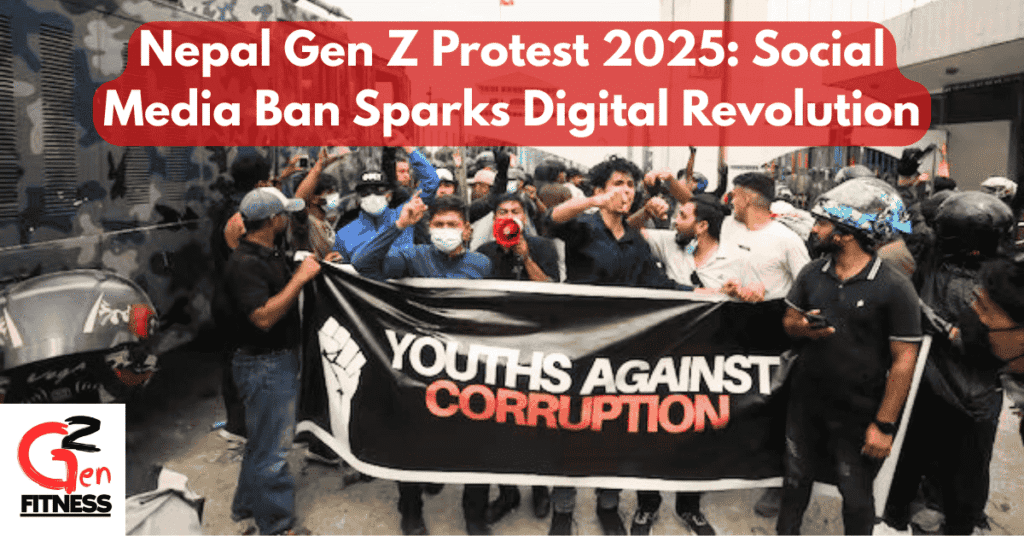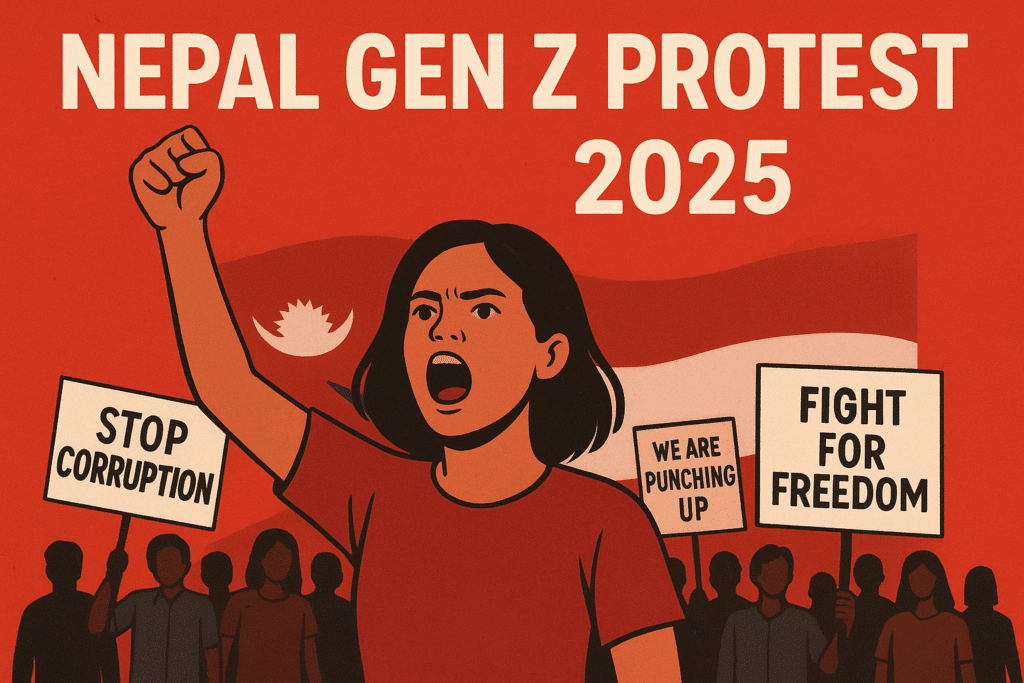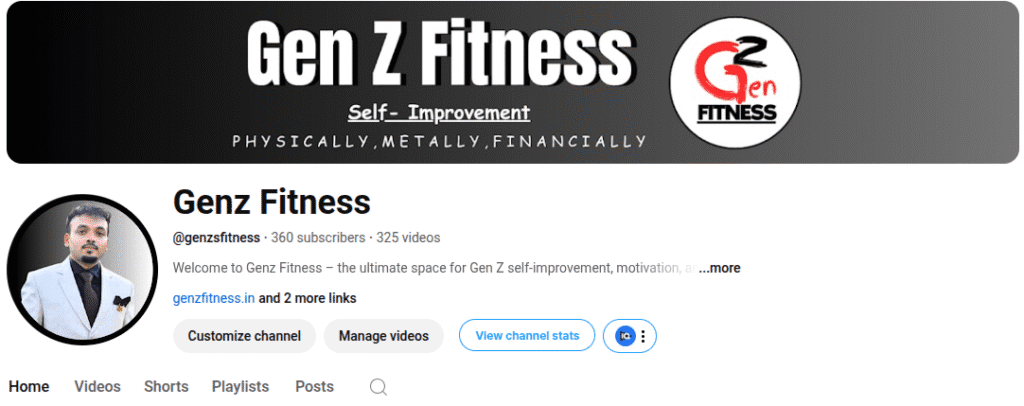

Nepal Social Media ban protest
So picture this.
You wake up one morning, grab your phone (because let’s be real, none of us actually “wake up” without scrolling first), and suddenly—Instagram doesn’t load. TikTok? Dead. WhatsApp? Ghosted. YouTube? Vanished.
That’s exactly what happened to students in Nepal earlier this month when the government decided to block 26 major social media apps overnight. No warning. No “we’ll phase it out.” Just poof.
And if you’re Gen Z, you already know—this wasn’t just about memes, reels, or sending streaks on Snapchat. This was about connection, freedom, and identity. And Nepal’s Gen Z wasn’t having it.
The Spark That Lit the Fire
The government said:
“Hey, these apps didn’t register under new regulations, so we’re shutting them down.”
Translation? They basically tried to “parental control” an entire generation.
Now, imagine being told you can’t use the very tools you study with, socialize on, or even earn money from. Like, how do you ban YouTube in 2025 when half of Gen Z literally learns more from YouTube than from textbooks? How do you ban Instagram when small businesses, creators, and even students are hustling on it for side income?
It wasn’t just a ban. It was like pulling the plug on Gen Z’s lifeline.
Gen Z Says “Nah, We’re Not Sitting Quiet”
Within hours, Nepal Gen Z protest exploded in Kathmandu and other cities. Maitighar Mandala, New Baneshwor—places that are usually buzzing with traffic and chai stalls—suddenly filled with thousands of students.
And it wasn’t just about scrolling rights. Their signs and chants said it all:
- “This is not just about apps—it’s about freedom.”
- “Stop corruption.”
- “We are punching up.”
That last one? Iconic. It became the slogan of the movement: The Final Revolution – We Are Punching Up.
Why This Hits Different
Let’s be honest. Older generations sometimes think we’re “too online.” Like, they roll their eyes when we say our life is on Instagram or when we complain about bad Wi-Fi. But for Gen Z, digital isn’t separate from “real life.” It is real life.
We meet friends online. We organize movements online. We even find jobs, partners, and communities online. Cutting that off is like telling a fish, “You don’t need water. Just breathe air.”
So yeah, no wonder students saw this as an attack on their identity.
The Government’s Reaction (Spoiler: Not Cute)
Now here’s where it gets messy. Instead of listening, the government doubled down.
Police came in with tear gas, water cannons, rubber bullets, even live rounds. At least 19 young people died, and hundreds more were injured.
Pause for a second.
Nineteen lives. People with dreams, crushes, side hustles, playlists, memes saved in drafts—gone. All because they dared to say: We deserve better.
It’s heartbreaking. And it shows how scared the powerful can be when young voices unite.


A Protest That Became a Movement
But the thing about Gen Z? We don’t quit. Even in tragedy, the movement grew stronger.
Celebrities like comedian Madan Krishna Shrestha, singer Prakash Saput, and director Nischal Basnet jumped in with messages of support. Kathmandu’s Mayor Balen Shah literally told the government not to politicize the protest. And youth across the country kept showing up, even with curfews and barricades.
This wasn’t just “students being dramatic.” This was a legit uprising against corruption, control, and an out-of-touch political system.
The Wins (and the Cost)
By September 8, after days of clashes, the pressure got too real. The government restored social media access. The Home Minister resigned.
On paper, Gen Z “won.” Social media was back. But let’s not romanticize it—19 families lost someone forever. And that wound won’t heal with a single policy reversal.
Still, the message was loud and clear: Nepal’s youth are awake, organized, and unafraid.
Why You Should Care (Even If You’re Not in Nepal)
Maybe you’re reading this from India, the U.S., Europe—wherever. You might think: Cool story, but what does this have to do with me?
Here’s the thing. Around the world, governments are testing how much they can control digital spaces. Bans, surveillance, censorship—it’s all creeping up.
If it can happen in Nepal, it can happen anywhere. And it’s always young people—the meme-makers, the students, the dreamers—who feel it first.
This protest wasn’t just about Nepal. It’s about what happens when our generation finally says enough.
The Real Lesson
What struck me most isn’t just the bravery. It’s how Gen Z managed to turn an online identity crisis into a real-life revolution.
Think about it:
- They organized with barely any tools.
- They didn’t wait for politicians—they led themselves.
- They turned frustration into a unified voice that even the government couldn’t ignore.
That’s the power of Gen Z. We’ve grown up with TikTok trends, sure. But we’ve also grown up with climate marches, Black Lives Matter, farmers’ protests, and now this. We know how to meme, but we also know how to mobilize.
My Take (And Maybe Yours Too)
When I first heard about this, I caught myself thinking: If Instagram got banned here tomorrow, would I protest? At first, I laughed. Like, it’s just an app, right?
But then I thought about it more.
Without social media, I’d lose my communities. My hustle. My place to vent and vibe. I’d lose a piece of myself. And suddenly, it didn’t feel silly at all.
That’s what Nepal’s Gen Z understood. They weren’t fighting for “screen time.” They were fighting for agency, freedom, and respect.
And honestly? That fight is global.
So, What Now?
The movement isn’t over. Social media might be back, but the bigger issues—corruption, nepotism, lack of accountability—are still there. Nepali youth are saying, “We see you. We won’t be silenced.”
And the rest of us? Maybe it’s time we stop underestimating our generation. Maybe it’s time we realize that the same kids making “delulu” TikToks can also change history.
Because if Gen Z in Nepal can take to the streets and shake up their government, what’s stopping us from demanding better wherever we are?
Final Thoughts
Nepal’s Gen Z protest isn’t just a news story. It’s a reminder.
That we’re connected. That our voices matter. That memes and movements can exist in the same breath.
So next time someone calls Gen Z lazy, screen-addicted, or “snowflakes”? Point them to Nepal. Tell them about the students who faced tear gas for their digital rights. Tell them about the young people who turned “losing Instagram” into “finding their power.”
Because the truth is, we’re not just scrolling. We’re shaping the future. One protest. One hashtag. One fearless stand at a time.
Why did Nepal’s Gen Z protest in 2025?
Nepal’s Gen Z protested after the government banned 26 popular social media apps, including Instagram, YouTube, TikTok, and WhatsApp. Students saw this as an attack on their freedom of expression and digital rights.
What was the slogan of the Nepal Gen Z protest?
The movement adopted the slogan “The Final Revolution – We Are Punching Up”, symbolizing the youth’s fight against corruption and political suppression.
How did the government respond to the protest?
The government initially cracked down with tear gas, rubber bullets, and even live ammunition. Sadly, at least 19 young people lost their lives, and many more were injured.
What were the results of the protest?
After days of nationwide protests, the government restored social media access, and the Home Minister resigned. However, the youth movement continues to push for deeper political reforms.
Why is the Nepal Gen Z protest important globally?
This protest shows how digital rights are tied to freedom and democracy. It also proves that Gen Z—often dismissed as “too online”—can unite and lead powerful movements for real change.
Which celebrities supported the protest?
Popular figures like comedian Madan Krishna Shrestha, singer Prakash Saput, and director Nischal Basnet expressed solidarity with the protesting youth. Even Kathmandu Mayor Balen Shah spoke in support.
How did social media play a role if it was banned?
Even with bans, young people used VPNs, offline networks, and on-the-ground organizing to spread information, showing Gen Z’s creativity and resilience.
What does this protest mean for Gen Z worldwide?
It’s a reminder that digital spaces are not “just apps” but essential tools for education, livelihood, and freedom. Gen Z globally should be alert to protect their digital rights.
Read more articles: https://genzfitness.in/


Please Support my Youtube Channel- https://www.youtube.com/@genzsfitness
